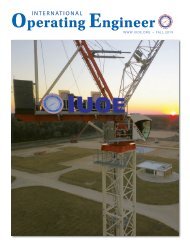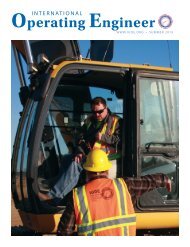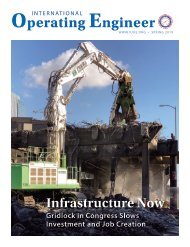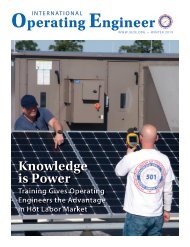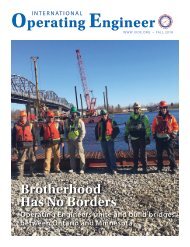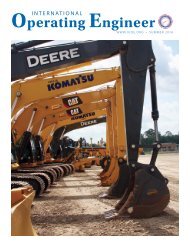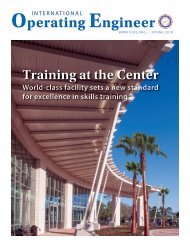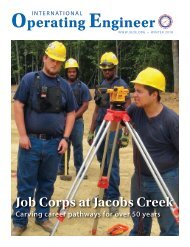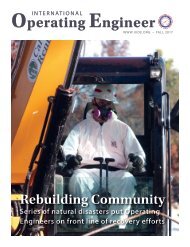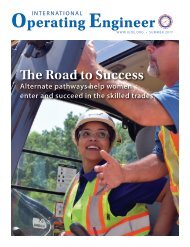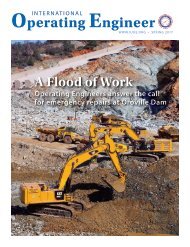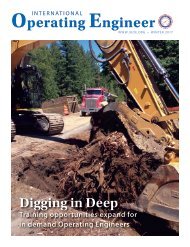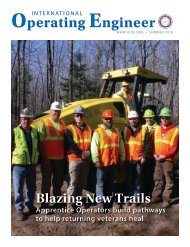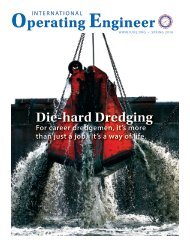125 Years Strong – An IUOE History
Celebrating the 125th Anniversary of the founding of the International Union of Operating Engineers
Celebrating the 125th Anniversary of the founding of the International Union of Operating Engineers
You also want an ePaper? Increase the reach of your titles
YUMPU automatically turns print PDFs into web optimized ePapers that Google loves.
INTERNATIONAL UNION OF OPERATING ENGINEERS<br />
Cranes operated by members of I.U.O.E. Local No. 4 in Boston work on construction of the Seabrook (New<br />
Hampshire) Station Nuclear Power Plant just north of Boston, which was built from 1976 into 1990.<br />
“Organizing nurtures and<br />
promotes our ideals and goals; it<br />
replenishes and expands our ranks<br />
and influence; it sustains our<br />
ongoing efforts to provide better<br />
and safer working conditions for<br />
our members. Without organizing,<br />
without the constant infusion of<br />
new blood, new ideas and new<br />
incentives, the union movement<br />
long ago would have reached<br />
its peak, then withered and<br />
disappeared through attrition.”<br />
The plan called for the creation of an<br />
Organizing Grants Program, through which<br />
the general president would award yearly<br />
“organizing grants” to locals based on the<br />
net increase in a local’s total membership in<br />
a defined 12-month period. (Just two years<br />
later, the program had paid out more than<br />
$600,000 to local unions for organizing new<br />
members.) The international also deferred<br />
one-half of the 50-cent per-capita-tax increase<br />
for each local scheduled to take effect on July<br />
1, 1990, to encourage locals to devote more<br />
resources to organizing.<br />
The program further immediately<br />
implemented an organizing campaign aimed<br />
at bolstering the union’s share of heavy and<br />
highway construction work in a 10-state region<br />
in the south and southwest. The international<br />
would coordinate the operation through the<br />
newly chartered Local No. 5, headquartered<br />
in Jackson, Mississippi, to organize and<br />
represent potential members in Alabama,<br />
Arkansas, Florida, Georgia, Mississippi, North<br />
Carolina, South Carolina, New Mexico, Texas<br />
and Virginia. At the heart of the effort was an<br />
agreement with contractors from around the<br />
country that established a standard benefits<br />
package and zoned wage rates to enable<br />
signatory contractors to be competitive in<br />
bidding work in that region.<br />
Throughout General President Hanley’s time<br />
in office, which would last into March 2005,<br />
much of the international’s focus was also placed<br />
on efforts to train and educate its members. In<br />
doing so, he initiated several new training and<br />
education programs and reinvigorated existing<br />
ones so that all members could have access<br />
to the resources and tools necessary to keep<br />
pace with changing technologies. “I am firmly<br />
convinced that if all of our local unions sign<br />
on and implement these programs, it won’t be<br />
long before we can reclaim much of our rightful<br />
market share,” he wrote in the February-March<br />
1996 International Operating Engineer.<br />
By the time 600 delegates gathered for<br />
the 34 th I.U.O.E. Convention in Chicago<br />
from April 5 to 8, 1993, whose theme was<br />
“Training for the Future,” the union’s Hazmat<br />
Training Program had educated over 600<br />
instructors and 20,000 members on working<br />
with hazardous wastes and materials; its newly<br />
initiated business agents’ training program<br />
and pipeline training program were off to<br />
strong starts; and its established organizing,<br />
apprenticeship and skills-improvement<br />
training programs were again serving to give<br />
the union a competitive edge. Those efforts<br />
had helped I.U.O.E. membership to grow<br />
back to about 369,000.<br />
Earlier that year, more than 100 business<br />
agents from locals throughout the country<br />
attended the international’s first two business<br />
agents’ training programs. The week-long<br />
sessions, one of which was held at the George<br />
Meany Center and the other at the Local No. 3<br />
Training Center in Rancho Murieta, California,<br />
covered topics such as legal issues; contract<br />
negotiations; grievances and arbitrations;<br />
pipeline agreements; national agreements;<br />
maintenance and general presidents’<br />
agreements; jurisdiction; heavy and highway<br />
industries; safety and health; prevailing wage<br />
laws; hazardous materials; and the federal<br />
McNamara-O’Hara Service Contract Act that<br />
requires contractors to pay prevailing wages in<br />
certain circumstances.<br />
Members of I.U.O.E. Local No. 150 of Chicago work on construction of the city’s “deep tunnel” system, which is being built to<br />
ease flooding and support water reclamation through 109 miles of tunnels ranging from 9 to 33 feet in diameter. Started in<br />
1975 and expected to be complete in 2029, the $4-billion job has been a large source of labor for Local 150, especially during<br />
the recessions of the early 1980s and 2010s, when it was a savior for workers who were otherwise struggling for employment.<br />
LABOR OMNIA VINCIT<br />
WORK CONQUERS ALL



